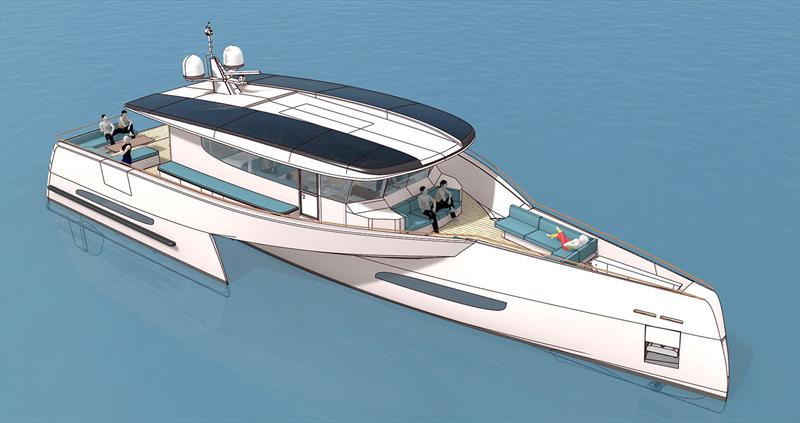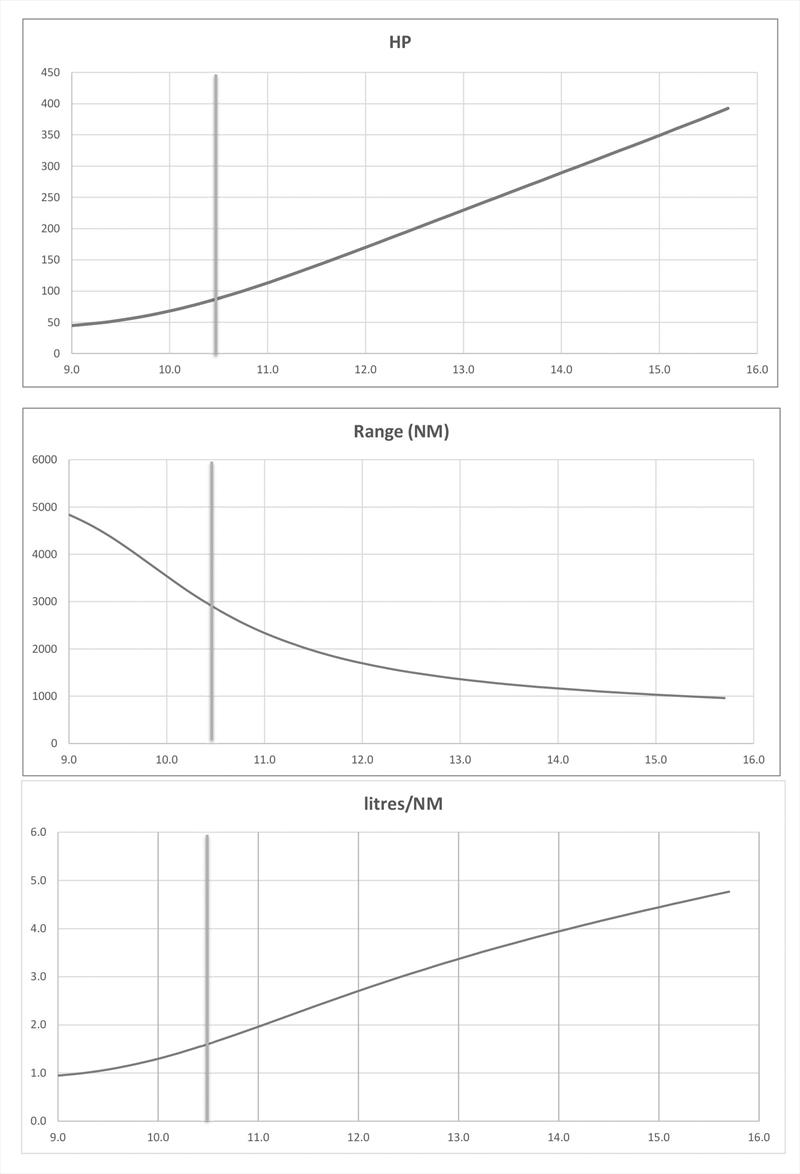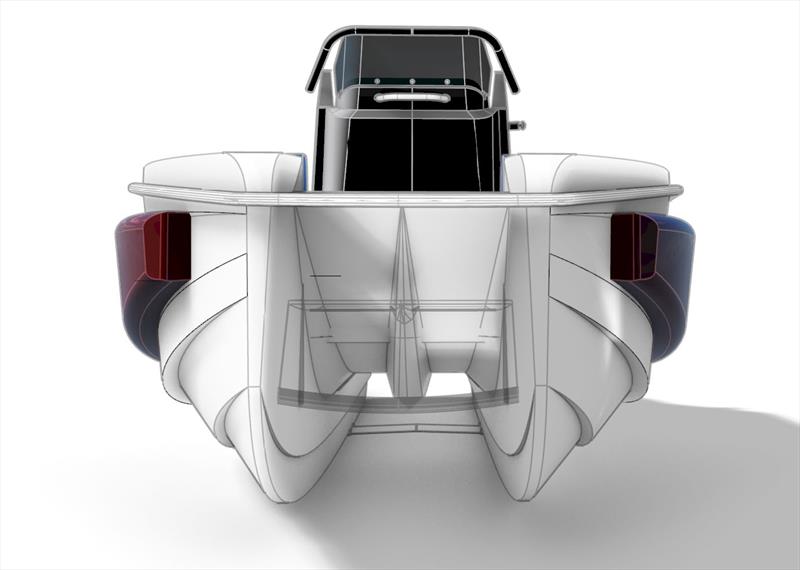
Upcycling your Recycling
by John Curnow, Global Editor, Powerboat.World 9 Aug 2023 12:00 PDT

Stabilised Monohull © Bury Design

Powering table for the 24m Stabilised Monohull ©Bury Design

Horsepower requirement, range, and fuel burn for the 24m Stabilised Monohull ©Bury Design

The VC5 Foil Assisted Tender for the Stabilised Monohull ©Bury Design
previous next - 1
- 2
- 3
- 4
- 5
- 6
- 7
- 8
- 9
- 10
- 11
- 12
- 13
- 14
- 15
- 16
- 17
- 18
- 19
- 20
The mighty Volvo Ocean 70 once held the sailing monohull record for point-to-point distance covered in a 24-hour period (Ericsson 4 covered 596.8nm @ an average of 24.86 knots). Believe it or not, the stabilised monohull you're looking at here is actually the carbon fibre mould for one of those now vintage gems from that all-conquering class.
For sure there is a false bow now added, and there has been a significant amount of cut and shut, especially out aft, where her very muscular hips to deliver incredible form stability once were. She's now a much more svelte item, and is all about using that smooth running surface to get places oh-so-efficiently.
However, it remains that the core structure once produced a racing hull that participated in the famous and arduous round the world crewed race.
In other words, pedigree, and plenty of it. You see, the reason that's all so important is that her owner likes to cruise long distances in blue water, and has thought long and hard about what kind of vessel he'd like for that job. Comfort, economy, practicality, versatility, and a certain level of style were all part of the mix, and possibly even in the very order we have just written them down.
Yes. This is what you build when it is going to be your own. It's for when you are a yachtie at heart, but you know power is the way forward? It's what do you do when you live in Southern Australia, and you know that the weather can be inclement all the way up the Eastern seaboard. Usually there is a seaway to contend with no matter which way you're heading, let alone the implications of the East Australia Current.
So what's to like?
Me? I like how miserly it is. Try 1 litre per nautical mile at 9.4 knots and just 1.6l/nm at 10.5 knots. That's truly green! I like how there are no common bulkheads between the accommodations. I like the military-esque styling. It's not so much Guided Missile Cruiser as it is stealth mission and would fit very nicely into Part II of Incoming! Man the guns - it's just a matter of when I get around to writing said epistle...
I also like how it can be a party boat. I like how it has a very cool tender. I like how it will cover off significant distances into or with a significant seaway, and just keep smashing out 11 knots or so for 260nm days, which can get you a lot of places.
Now we know a thing or two about her owner, and we kind of got a hint at this project back with Not a movie. (As yet...) and then a further nudge with an avant-garde explorer yacht. He is Paul Bury, and this stabilised monohull is a reality, with the panels for some of the internal structure and her distinctive arma hulls already in the works.
Bury is a Naval Architect, having spent time at Wally Yachts, as well as Bill Tripp's office, and knows a thing or two about aeronautical engineering, to boot. The great thing about this project is that it is his own, for him and his family and friends. Yes, it will go into survey (basically covering structure (flotation), fire protection, damage, and stability) to do inshore and coastal charter work, but its main mission is to be able to go places efficiently and in a lot of atypical or prevailing weather conditions, which are often not the most amenable on the planet.
What's it going to do?
In his own words then, these are the mission parameters. "This is to be a primarily an owner operated vessel capable of long ocean passages, but also suited to coastal cruising. So it is mostly for private use, but is also suitable for day charter (50 POB in sheltered waters), and then overnight charters (6 POB/2 crew) in open waters."
Given he lives in Gippsland in Eastern Victoria that backs onto the world-renowned Bass Strait, comfort as sea, economy of operation, and the ability to punch through the inevitable Southeast Australian coastal chop were seen as 'critical', as Bury puts it.
Also highlighting his real-world appreciation for use at sea, the vessel's construction, stability and damaged stability are to Australian Commercial NSCV standards. The main hull is 8mm solid carbon fibre. The outer hulls, internal structures, decks and cabin are to be PVC foam, with E-Glass/Vinylester skins.
Additionally, all machinery/fitout to be either commercial marine or domestic as much as possible. Serviceability of all items is a 'must', with Bury again highlighting all he has known from the many passages he has undertaken. Indeed, one of our conversations in the development of this piece took place whilst Bury was delivering a 50-foot powercat back South from warmer Northern climes...
Also stemming from experience is the way all four cabins have no common bulkheads. They even have individual access. They offer Queen beds, and a usable en suite, so will be quiet, private places, if not palatial. There is also a full-size laundry aft and a full-height engine room with workshop.
What's this thing do?
And so we get to the shove. A single main diesel of 350hp will drive a massive, single, 1300mm controllable pitch propeller (CPP) for very high propulsive efficiency.
"You have a propeller curve, except that that curve doesn't match the engine output. It's almost the opposite, and with controllable pitch, you can pitch up the propeller to suit the power curve of the engine. You can set the engine RPM for minimum specific fuel consumption, which is all about achieving the least amount of fuel burn per kilowatt output that uses, and there's a fuel chart for every engine that gives you where the sweet spot is, and you tailor the pitch to suit that."
"Essentially, you're picking the most fuel-efficient part of the engine range to operate at. It's how controllable pitch gives you so much flexibility, and also manoeuvring efficacy, as well. You don't need a gearbox. You can set the propeller so that it's minimum drag if you're using the electric propulsion system in the outer hulls and things like that." It is a complicated and expensive thing for sure, but it's actually fulfilling the main part of the dream, to be honest.
"It's great. You can have your propulsive efficiency at like 60% versus about 50% on a fixed pitch propeller at cruising speed. So essentially a 10% increase in efficiency, or decreasing fuel burn, and that's pretty significant if you're going long distances."
Electric drives in each Arma hull are for in port propulsion and manoeuvring via digital controllers. The big outboard rudders are for control of her whilst under way. 5000 litres of fuel give a comfortable 3000nm range at 10 knots, with suitable reserve. 350hp delivers 15.5knots WOT.
This is a long vessel, but it is also beamy, and staying in port or at a marina could become costly, very quickly. To counter this, a twin (petrol or electric) waterjet 5m tender will be stowed on the foredeck. The VC5 tender (based on the Vapor Cat 5 fishing vessel) will have a collapsible centre console to maintain sightlines, and be launched and retrieved via a plug-in carbon fibre davit.
Keeping up with the efficiency angle and the VC5 will deploy a foil between the hulls for lift, and also have a bow ramp for beach access, so the jets are crucial to this part of the equation, as well. A big platform aft on the centre hull will make for easy access onto and off the VC5 tender.
As the mothership will spend time at anchor, she has twin bow anchors and a single stern anchor to aid in holding position.
The Big Boat
Just like a massive puzzle, the centre hull is with Paul in Gippsland, and the lion's share of the remainder will be finished up in Thailand and sent for fitment. It makes sense as he has a quality workforce there able to do all the laminating, spraying and finishing work to a superlative standard. In this instance, pre-fabrication certainly beats reinventing the wheel all over again.
Apart from the bow, the new stern of the main hull incorporates large steps and a proper platform to perform transfers to the tender. In addition to gaining yet more LWL from her 24m overall, the stern also houses the centralised, automated, stern anchoring system that is so central to the whole ethos of the vessel that is a direct result of her hefty 8.2m beam.
The plan calls for a good boat that you do not want to get off too often, anyway. Supplies, the occasional restaurant and that sort of thing... You'll have plenty of water for showers aboard your comfy, stable home away from home, and peace, space and maybe even some Zen.
Two of the main things happening to the main hull are narrowing it for lower resistance and the trimming of her proportions out aft. "It's more like a double ender in the water, now", said Bury. "We have a very small immersed cross-section in the stern." The huge aft planing section that you need for a Volvo 70 that was looking at sustained planning speeds of 25 knots is not required here, and so it is well and truly gone.
Then there is the installation of the collision bow, which also helps to alter the overall profile. Note, however, that there is plenty of room because they are not trying to jam four cabins in, just the two, and you no longer have to deal with mast steps, canting keel mechanisms and so forth.
Now 11 litres might sound like a lump of iron, but if it is only trying make 2200 RPM and you match the pitch to the efficiency of the engine, then the equation tilts to your favour, because of the incredible drive from the big wheel below. Of course, being a former racing yacht, the idea is not to get the bow up, but to keep the bow in.
"We're not even going in anywhere near transition speeds to planing. This is fast displacement. I do not want to do 22 knots, but this sort of hull form could easily do that, but it's not where I want to be. I don't need to go that fast. If you're going distances you are slower. In a planning hull vessel you might do 18 or 20 down the coast, but you are not going to New Zealand at those speeds."
This stabilised monohull is all about the 12-15 range for the shorter stuff that Bury intends to do and then 1000-mile passages at 10. "They're good days, you know; 240 miles a day, everybody's happy. At 14 you are kind of triple the consumption you achieve at 10, so this is where my mind is at. Typically, around these parts you have 1-2m of seaway to contend with and too fast is too awful!"
Footprints on the sea
"Catamarans don't generally like short, ugly chop I am pretty firmly convinced that this thing will punch a lot better than a catamaran will. For sure about 80 feet of catamaran will probably do similar things to this, but it's going to be such a massive boat volume wise, and it's just beyond what I need. They serve a purpose, but six double cabins are too much."
"Want maximum accommodation for your essentially footprint size, then get a catamaran. The accommodation per length is unbeatable. It's a big box, so you can fill it full of all sorts of stuff, and people do. And if you want to sit in a marina pen and entertain people, it's a pretty good option." Note again that the stabilised monohull can still carry 50 on her expansive deck space.
"This is a different brief. I think this stabilised monohull is a good compromise, and it'll punch extremely well. This kind of hull form can have issues in following seas, as they pick up the outer arma, and try to broach, but that is why we have those large rudders way out wide. There is no rudder on the centre hull."
So it is about the volume below, and if six cabins plus crew space is your bag, then get a Sunreef 80. It will weigh a lot more than the stabilised monohull's 20 metric tonnes too, and there'll be a pair of 800hp Diesels involved, as well.
The overarching concept is to look good so it will still be loved in 10 years, and have a miserly fuel burn and good seakeeping in non-Mediterranean conditions. "And we are not relying on mechanically intensive stabilisation, either", added Bury. "The platform is stable and comfortable, and I don't need the gyro running 24/7."
Yes. Decidedly, this is a boatie's boat, and that's why it will also help pay its way, too. "It's always a compromise, but this is a compromise that I've driven, rather than a client has selected."
It's a package deal - the tender is integral
It's quite the deal, like it's big sister. It is glass and carbon with a couple of little inboards driving the jets and is foil assisted for making the higher speed work as efficient as possible. The core hull is in production now, but as an outboard fishing boat.
The cool aspect are those medium density foam fender pads along the topsides, which serve not only as protection for all craft, but aid the buoyancy, so that the internal spaces of the hull can be dedicated to thinks like protecting shopping from spray, or taking dive tanks. One could even be a fish well. Versatility, stability, ride, and pace are what sell tenders, no matter what size.
"It performs like a seven-metre boat. It is unbelievable, and with the foil it is mind blowing how good it is. VC5 will be an awesome tender with a jet and a bow onto the beach ladder system. If the tide goes out, it doesn't matter, it can draw itself off unless there have been massive tides and your jets come out of the water."
Part of the reason I like the VC5 is that the tender market is very competitive and often gives over to RIBs, but a small cat has many distinct advantages, and this one highlights them oh-so-marvellously. You just have to see towards the end of the video below, where there is a person standing right atop the prow, and not going in as the boat does not roll over.
Even the control of jets has improved over time, so they can be as clever as digital, proportional joystick control of individual outboards. Like everything, it is always a matter of budget. Vectoring thrust is best handled by computers, but is no longer a case of a bucket going over a jet that can only operate in ahead, and hoping you have enough grunt to not smack into the fast-approaching pier.
Looking good is not just the job of the very vessel you are on, but the skill of the pilot as well.
Stand by and just look for mini-me(ish) to be up and running before the mothership leaves space dock.
In the end, a vessel like the Bury stabilised monohull could do wonders for upscaling your downtime, and last time I checked, this is one of the key reasons to go boating in the first place. Cannot wait to see this project unfold, now that the first reveal is complete.
OK. Today you will find that the site has an abundance of material from right across the globe, and if you cannot find something, just try the search button right up the top of the landing page, above our logo. If you cannot find what you want or wish to want to add to that, then please make contact with us via email.
Finally. Please look after yourselves.
John Curnow
Global Editor, Powerboat.World